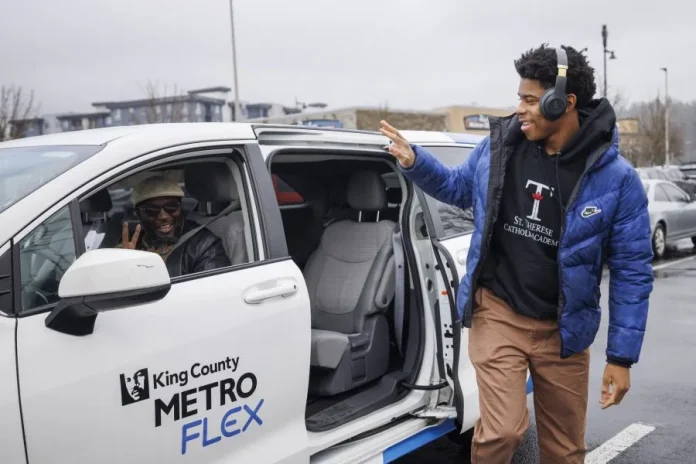
In March, King County Metro launched Metro Flex, an on-demand neighborhood van transit service. With a handy app, users can book rides to destinations within the seven separate designated service areas in Issaquah/Sammamish, Juanita, Kent, Othello, Rainier Beach/Skyway, Renton Highlands, and Tukwila. As with any new transit service, Metro Flex extends the boundaries of accessibility and transport in the region. I personally live in an area that wasn’t served by transit until Metro Flex came along. But is the service actually good and reliable?
According to some, there’s a lot left to be desired. The Metro Flex app currently has a 2.3/5 star rating on the App Store and a 2.5/5 star rating on the Google Play Store. Although app store reviews aren’t the best indicator of service, they still provide important insight.
One user says, “The drivers for the most part seem to be cool, professional, and polite.”
Another writes, “Not enough drivers.”
And another says, “There needs to be more vehicles available.”
Casey Martin of KUOW Radio writes in his Metro Flex review about a persistent app popup that reads, “We’re sorry to report that we’re currently experiencing a technical issue. We’re on the case, and we should be up and running soon!”
Social media reviews:



And there are many other caveats to Metro Flex service. For example, the app may lead you to use a nearby Metro bus that may take a longer time instead of a Metro Flex van.
With these mixed reviews in mind, I decided to try Metro Flex myself.
I started my journey in Metro Flex’s Kent service area at Kent Station. Kent Station is a shopping center just north of downtown Kent and next to Kent’s Sounder Commuter Rail Station. Unlike what some of the reviews said, booking a ride on the Metro Flex app was quite simple. After setting my location and destination, I was left waiting a few seconds so the app could process my request. The app then found a location for a nearby pickup point that helped make the van’s route efficient. After confirming all of the details, I was luckily able to book a van. However, I had to wait another nine minutes before the van came, which gave me some time to stroll around Kent Station.



As the van steadily approached my location, I walked over to the nearby pickup point where the Metro Flex van picked me up. Like an Uber, the driver confirmed my name and used a phone to navigate and accept ride requests. Sitting in the van, a newer Toyota Sienna Hybrid, I felt a bit cramped but was otherwise fine. Like a Metro bus, there was a screen that divided the driver’s compartment with passenger seating and an ORCA card reader.


Only then, however, was I able to view the van’s whole route on the app, which included picking up and dropping off another rider. In total, that meant my ride would be around 25 minutes long – 10 minutes longer than if I were to drive myself, according to Google Maps.


After the driver dropped me off right at the dropoff point, the Metro Flex app had a popup that asked for a rating. I gave it five-stars. At first, considering the negative reviews led me to drop my expectations to rock-bottom, but in the end I was pleasantly surprised by the ease of the whole process.

And a few minutes later, I received an officially emailed receipt from Metro Flex about my ride.

Overall, Metro Flex is a service that has a lot of potential. More vans and drivers, like the app store reviews mention, would be a great help to increase availability and get more people around. But, in the face of constrained budgets and a shortage of labor, King County Metro is unlikely to do so in the near term. What is within their power, however, are some updates to the Metro Flex app that could increase its accessibility, such as bug and error patches and a retooled algorithm for routing vans more efficiently.
Compared to other microtransit services, like LA Metro’s Metro Micro (see City Beautiful’s review), Metro Flex feels a bit under par. Considering that Metro Flex is less than a year old, it still is trying to develop a reliable and sustainable service.
In any case, it will be interesting to see how Metro Flex will evolve, and hopefully becoming a staple in King County transit.

McNielle Galindo (Guest Contributor)
McNielle is a high school senior who became interested in urbanism after growing up as a train enthusiast. He is a member of multiple volunteer groups, an avid reader, and loves maps.
